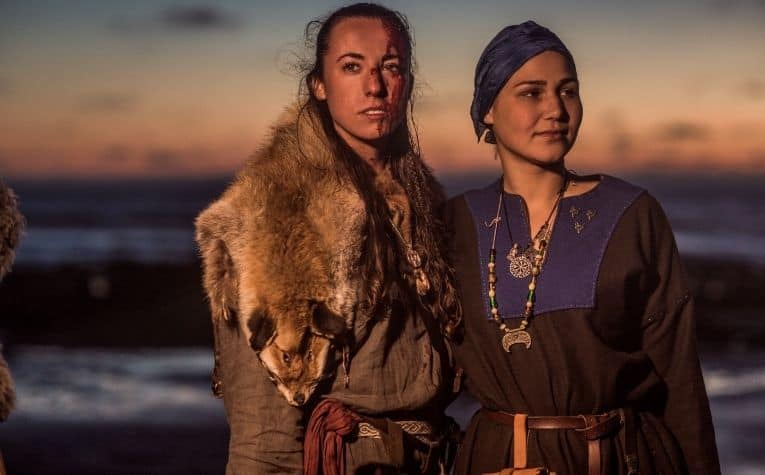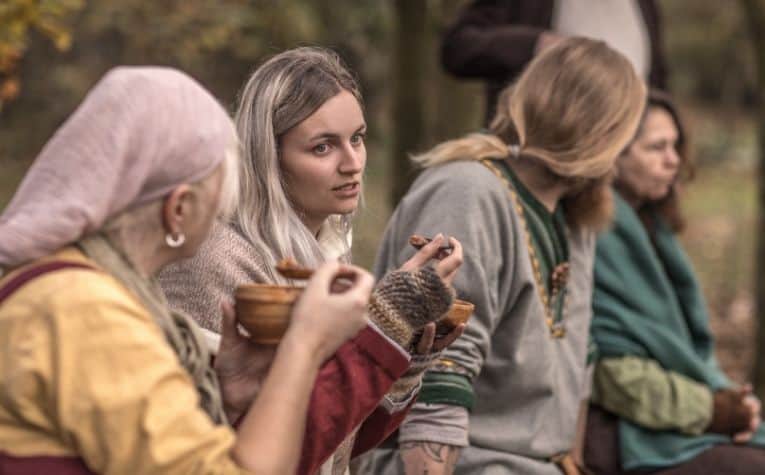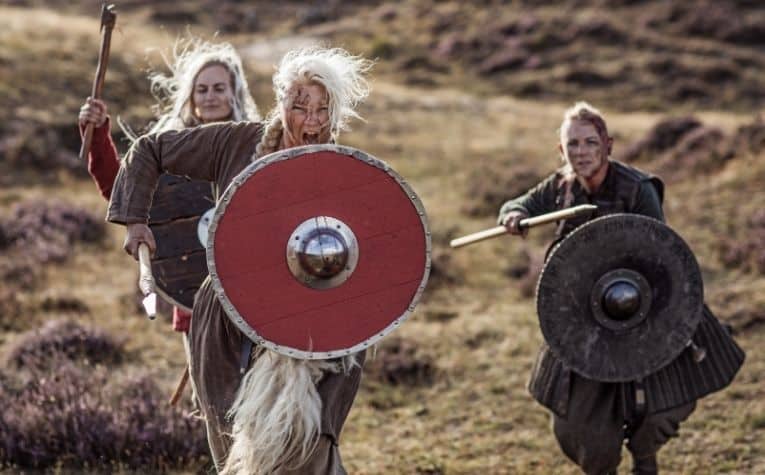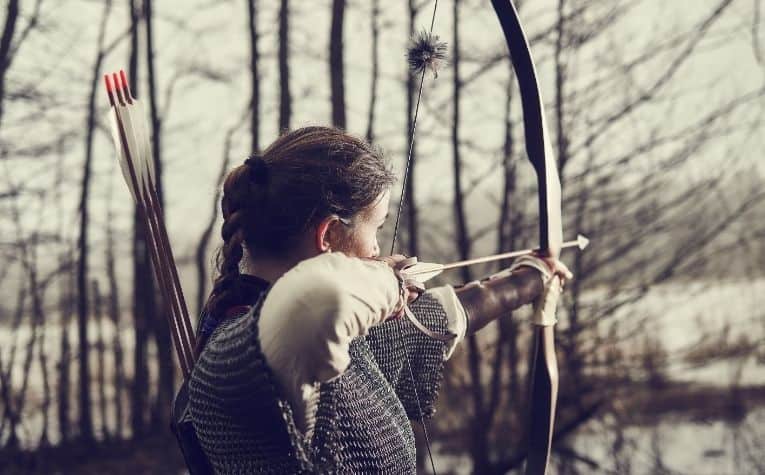A common perception of the Vikings is that theirs was a male-centric society.
To a large extent, it was, but Norse women enjoyed rights and freedoms that were very progressive for the times.
They could divorce their husbands, own property, and engage in a trade.
Although the matter is hotly debated, archeological evidence suggests that there were also female Viking warriors who fought alongside men.
The only measure by which Odin and his Valkyries selected fallen warriors from fields of battle to join them in Valhalla’s great halls was whether they were courageous and valiant until their death.
Thus, if a female Viking warrior fought and died with valor, she could find herself in Valhalla.
The Norse people did not have written scriptures prescribing the manner by which Viking warriors were deemed worthy of entry into Valhalla.
Simply put, those who were killed in action were eligible, seemingly without regard to their social status.
As revealed by the Viking sagas and later supported by archaeological excavations, there were no restrictions based on gender either.
Separate fact from fiction about Valhalla. See Is Valhalla Heaven or Hell? 10 Facts That May Surprise You to learn more.

Did Female Vikings Enter Valhalla?
Throughout Viking history, there were esteemed women who were recognized for their:
- Bravery
- Leadership
- Standing in their community
Norse poems and sagas tell their stories, and archaeological discoveries reveal that some Viking women attained near-chieftain status while others may have been highly decorated warriors.
The Vikings believed in the afterlife and recognized five separate realms where their dearly departed could find themselves upon death.
For warriors, the greatest honor would have been to earn entry into Valhalla, where they would train with other fallen heroes by day, feast with Odin and his Valkyries by night, and awaken to repeat this routine again and again until the day of reckoning.
Norse mythology and religion did not preclude female Viking warriors’ selection from joining Odin’s ranks in Valhalla.
Only the bravest and most valiant of fallen Vikings were selected.
Ultimately, they would be tasked with fighting alongside Odin in the great battle that would mark the end of the world and the demise of nearly all gods and living things (including these warriors) during Ragnarok. [1]
Interested in Norse Mythology? See 14 Great Books on Norse Mythology that explain the gods, heroes, and villains of these ancient stories of Scandinavia.

Did Female Vikings Fight Alongside Men?
If it is accepted that female Vikings could enter Valhalla, then instances must be found where they took to the field of battle alongside their male counterparts and died with honor and valor.
Without question, the Vikings recognized women’s bravery in their society, and there are riveting tales in Norse sagas and myths describing female Vikings taking up arms and fighting with remarkable distinction.
There is debate whether the iconic shield maidens of Viking lore are based on mythology or reality, but they are heroic by any measure in either case.
And as recent evidence suggests, they were true to life. (Also see What Hairstyles Did the Vikings Have?)
The Birka Warrior
In 1878 a team of archaeologists uncovered a series of tombs (1,100 of them to be exact) in a former Viking settlement known as Birka, located in what is now Sweden.
The Birka excavations revealed two gravesites that contained caches of various:
- Weapons
- Military attire
- Gaming sets of the type believed to have been played by high-ranking officers to hone their strategizing skills
Separate fact from fiction. See The Truth About Viking Women: 15 Facts to learn more.
Among the recovered grave goods from the so-called Birka Warrior’s tomb were:
- 25 armor-piercing arrows
- A fighting knife
- A gaming set consisting of three dice made from antlers and 28 playing pieces
- A sword
- An axe
- Lances
- Shields
- Skeletal remains of two horses which when considered with the arrows and cavalry-type attire also found in the grave indicate the Birka Warrior may have been a horse-mounted archery specialist
Over a century later, scientists in 2017 determined through DNA analysis that the skeletal remains from one of the graves were, in fact, female.
Even though Norse sagas vividly described the exploits of so-called shield maidens, the notion that a real-life female Viking warrior had been discovered brought great criticism from experts who argued that the scientific evidence must have been contaminated.
In 2019, the DNA results of all recovered skeletal remains from the Birka grave were confirmed to be exclusively female with no Y chromosomes indicating male DNA presence.
Thus it appears that archaeological and scientific evidence conclusively proves that female Viking warriors did exist and that they were highly respected by their peers and revered by their community. [2]
Relationships were important in Viking society. See This Is How the Vikings Proposed and Got Married to learn more.

The Solør Warrior
In 1900, another Viking tomb was excavated on a farm in Solør, Norway. This grave was determined to contain a warrior’s remains as indicated by the presence of military weaponry similar to those found in the Birka Warrior’s grave.
And like the Birka Warrior, modern-day scientists have concluded that the Solør Warrior was a female Viking who fought, and likely died, alongside male Vikings.
While the Birka Warrior may have been a high-ranking military officer judging from the uniform and gaming set she was buried with, the Solør Viking was likely a lower-ranking warrior.
What is most interesting about the Solør warrior is that her skull indicates a battle wound to the forehead that was inflicted by a long-bladed weapon such as a sword.
The head wound is not believed to have been the cause of the shield maiden’s death as it exhibits signs of healing.
However, this find provides a strong and compelling clue as to the existence of female Viking warriors who lived and died by the sword.
Interestingly, a facial reconstruction of the shield maiden’s skull has revealed a fair-complexioned woman whose charming appearance belies her violent vocation. [3]
How did Viking women wear their hair? Functionally or fashionably? See Did Vikings Have Long Hair? to learn more.
The Shield-maidens Lagertha and Rusla
The Norse people did not maintain a historical record of their society and relied on oral traditions to pass down their belief system from one generation to the next.
A few pseudo-contemporary writers wrote extensively of the Vikings years after the fact, including the Danish historian Saxo Grammaticus, whose Gesta Danorum is often referred to for glimpses into Viking society and culture.
In Gesta Danorum, Saxo Grammaticus tells the tale of a shield-maiden named Lagertha, a member of Norwegian King Siward’s royal family whose bravery and fighting skills were so extraordinary that they caught the eye of legendary Viking hero Ragnar Lothbrok.
Together, Lagertha and Ragnar avenged his grandfather’s death, King Siward, at the hands of rival Swedish King Frø.
So prominent of a figure was Lagertha in Viking lore that she has seen a strong resurgence in recent years as a popular and major character on television. [4] [5] (Also see Were the Vikings Tall?)
Gesta Danorum also describes the exploits of another Viking shield-maiden named Rusla.
Exiled from her native Denmark after sparking a revolt, she took to the high seas and became a feared pirate known as the “Red Girl.” (She later became a major figure in Irish folklore as a result of her marauding activities.) [6]

The Valkyries and Valhalla
While scholars and historians continue to debate whether shield-maidens and thus female Viking warriors truly existed, what is beyond dispute is that Norse mythology clearly establishes that there were females in Valhalla.
The Valkyries (Old Norse for “choosers of the fallen”) were maiden deities who called Valhalla their home.
Not only did the Valkyries accompany Odin in the great halls of Valhalla, but they also assisted him with the selection of those fallen Viking warriors.
Those chosen warriors would later rise from the dead on the battlefield and join them in the Viking afterlife, where they would await the arrival of Ragnarok.
According to some Norse poems, the Valkyries were actually responsible for determining which warriors would die during battle and which ones would live to fight another day. [7]
Also see What Did Clothes Did the Vikings Wear? to learn more about Viking society.
Final Thoughts
As described by Norse sagas and evidenced by real-life archeological finds, female Vikings earned entry into Valhalla and did so with distinction.
References:
[1] ancient eu
[2] smithsonianmag.com
[3] livescience.com
[4] mythologian.net
[5] history.com
[6] history.co.uk
[7] norse-mythology.org
